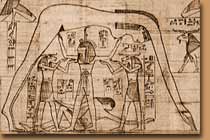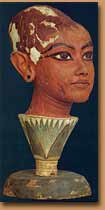Because
it relates the creation of the entire world, the creation
myth (also called cosmogony) is generally regarded as
the most important of all the myths in a culture. The
creation of the world is the theme of several ancient
Egyptian myths, yet four of them take precedent over the
others: the creation myths of the cities of Heliopolis,
Hermopolis, Memphis and Thebes.
The Heliopolitan Cosmogony
Allusions to the Heliopolitan creation myth have survived
the passage of ages in the Old Kingdom Pyramid Texts,
the Coffin Texts of the Middle Kingdom, the Book of the
Dead (New Kingdom) and Papyrus Bremner-Rhind. None of
these textual sources actually have a full narrative of
the creation of the world as established by the priests
of Heliopolis; however, the various references in each
text allow the reconstruction of the crucial moments of
the creation story.
The ancient Egyptians did not perceive the coming into
being of the world as a creation ex nihilo (out of nothing).
Instead, at the very beginning there was a chaotic primordial
watery body called Nun. Nun, even though it was 'pre-existence'
and never really part of the real world, contained all
the elements -- albeit inactive -- necessary for the creation.
Within this pre-existing aquatic milieu, the god Atum
willed himself into existence and emerged from the watery
chaos. Henceforth, Atum was known as 'The One who Created
Himself.' Having nowhere to stand Atum then created the
first hill, which also emerged from Nun. The imagery of
the first hill emerging from the waters of the primordial
ocean would have been familiar to any ancient Egyptian.
Every year, after the flooding of the Nile River, the
submerged land suddenly re-appeared like little sand hills
as the river receded and the water level lowered. The
Egyptians believed that the annual flood was a repetition
of the time of creation, the First Time.
Atum's next task was to create other gods. However, standing
alone on the first hill, he had to perform this feat without
a mate. Utterance 527 of the Pyramid Texts and Papyrus
Bremner-Rhind both state that Atum grabbed his phallus
in his hand and masturbated in Heliopolis. The twins Shu
(male) and Tefnut (female) were born as a result of his
orgasm. It is generally said that Shu was spat out and
Tefnut vomited from Atum's body.
Shu, the god of air, and his sister-wife Tefnut, the goddess
of moisture, coupled and continued the works of creation
by begetting the gods Geb and Nut, two very important
deities. The ancient Egyptians viewed the earth as a male
entity, the god Geb, and the sky as female, the goddess
Nut. After the Earth and Sky gave birth to four children
(Osiris, Isis, Seth and Nephthys), Atum ordered that they
be disentangled from their loving embrace and separated
from one another by Shu, the air (see image below).
|

|
| |
These
nine gods (Atum, Shu, Tefnut, Geb, Nut, Osiris,
Isis, Seth and Nephthys) are called the Ennead
of Heliopolis. The first five deities each
represent an element of nature: the sun, air,
moisture, earth and sky. The four others,
together with Geb and Nut, play the leading
roles in the myth of kingship, which will
be presented in a later lesson. |
|
|
The Hermopolitan Cosmogony
The Hermopolitan creation myth is unlike the other creation
stories. It distinctive trait resides in the fact that
its formulators believed that the entities who set the
creation of the world in motion lived in a Golden Age
before the First Time. They believed it actually pre-dated
the Ennead of Heliopolis.
In the Hermopolitan cosmogony, the chaotic primordial
watery body was described as more complex than Nun, as
seen in the Heliopolitan creation myth. Nun represented
only part of the primordial slime. Actually, eight entities,
who were divided in four couples, composed the primordial
ocean. Male deities were depicted as frogs and the goddesses
as snakes, and each pair represented a concept describing
the pre-world :
Nun (m) and Naunet (f) = primeval waters
Heh (m) and Hauhet (f) = eternity
Kek (m) and Kauket (f) = darkness
Amun (m) and Amaunet (f) = invisibility
Eventually, the Eight (also known as the Ogdoad) interacted
explosively and the blast of their powers resulted in
the bursting forth of the first hill from the watery chaos.
The primeval hill is often referred to as the Isle of
Flame because the creator god Ra (the sun god) was born
on it and the universe witnessed its first sunrise.
The Ogdoad's part in the story is most important in the
fact that in Hermopolis they were believed to have created
the sun god. However, after creation is set in motion,
the Eight -- with the exception of Amun -- retire from
the narrative and go live in the underworld where their
power causes the Nile to flow and the sun to rise each
day. As for Amun, he left Hermopolis and took residence
in Thebes, where he plays the leading role in the Theban
cosmogony.
The complexity of the Hermopolitan cosmogony is partly
based on the scantiness of textual evidence recounting
the creation myth. Most of the evidence for this narrative
comes from Theban monuments rather than Hermopolis itself.
Indeed, the destruction (or possibly 'unexcavation') of
the monuments of El-Ashmunein (the modern name for Hermopolis)
leave little for the understanding of the creation of
the world by the Ogdoad and the sun god. An additional
reason for the intricacy of the myth resides in the multiple
versions of the story. |

|
A version of the Hermopolitan cosmogony involves
a celestial goose. This goose, commonly known as
the Great Cackler because it was the first creature
to break the silence, laid an egg on the primordial
hill. The sun god Ra, who thereafter continued the
creation process, broke free from this egg. In another
slightly different (and later) version, it is an
ibis that lays the egg on the island. This later
version was adapted to the story of the Ogdoad because
the priests of Hermopolis wanted to promote their
local god Thoth (whom the Greeks knew as Hermes,
hence the name Hermopolis). An association with
the Ogdoad would have given Thoth more power and
seniority over other popular gods.
The most poetic version of the Hermopolitan myth
reverts to creation coming out of the chaotic primeval
ocean. Indeed, in this rendition of the story, it
is a lotus flower that is said to emerge from the
waters. The petals of the lotus flower unfolded
and sitting on the calix (the centre / heart of
the flower) was a divine child, the god Ra. A remarkable
sculpture found in the tomb of King Tutankhamun
shows the head of the young king emerging from a
lotus flower, the petals fanning out around his
neck -- an image that depicts the young king with
the powers of the creator god Ra (see image left).
|
|
In
a variation of the lotus flower theme, it is a scarab
beetle that emerges from the petals of the flower and
who then turns himself into a little boy who weeps. The
scarab beetle is an important symbol of the sun god Ra
and this will be explored in later lessons. |
| End
of Part 1 |
|